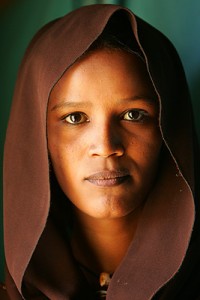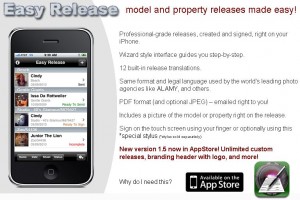I get a ton of questions regarding model releases, and to tell you the truth, I rarely if ever get them because most of the images I create are for editorial use. That being said, there are occasions when I want or need to obtain a model release.

Woman, Wad Shamam, Sudan (no, I did not get a model release)
It’s always a pain digging through the camera bag (which is usually back at the hotel, or in the vehicle, too far away to get at) for a paper copy of a model release. So, when I learned from my friend Matt Brandon (The Digital Trekker) about Easy Release, available as an iPhone App, I went ahead and grabbed it for $9.99. It’s an amazing tool which just eliminated another piece of paper that I had to worry about carrying around. Wow, every time I am away for a few months I come back and something newer, faster, easier has come along!
Easy Release works like this…you download it onto your iphone or ipod touch, fill in the “photographer details” and next time you need to get a release you follow the on-screen instructions, and have the subject of your photo sign right on the screen of your iPhone. When it’s all done, you email yourself, and the model a copy (including a PDF with a photo if you like) and you’re done!
Be advised, it does take a bit of time to fill in all the information using the tiny screen on your iphone, as you stand there, in the field with the model, but in the long run, having a digital copy makes a lot of sense, and the time and effort is probably worth it.
Here’s the link to the App Store page for Easy Release
Below please find and exerpt from the American Society of Media Photographers about model releases. (full tutorial here)
“A release is a written agreement between you and the person you are photographing, or the person who owns the property you are photographing. The purpose of the release is to protect you from any future lawsuits the person might file for claims such as defamation and invasion of privacy.
A model release says the person being photographed has given consent to be photographed and to the use of the images you capture. It doesn’t just apply to professional models or situations where people know they are posing for photos. You should seek to get a signed model release any time that your photos contain recognizable images of people, unless you are certain that you will never want to use them for anything other than editorial purposes.
A property release says that the owner of a certain property, such as a pet or a building, has given you consent to take and use images of the property. You don’t need one for public property, such as government buildings (although you may run into problems just from photographing them, for security reasons). But for images of private property — and particularly of objects that are closely identified with specific people — you are safer if you get a release.
The releases you obtain should be saved forever and should be linked in some way with the photographs to which they relate. You can expect to be asked to produce them whenever you license an image, and you will need them if you ever have to defend yourself in court.”











I think the iPhone app will look less intimidating than a paper release contract.
I’d be interested to know if you get more people to agree to sign the electronic release than you do with a paper version.
Yes, the iPhone app is kind of cute and novel, so yes, it’s less intimidating and more fun for people. I rarely get releases, so I don’t have enough data to say if one is more successful than the other. But since I got this app, I have been leaving my paper releases back at the office.